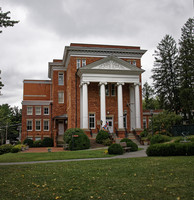 | Back to e-WV
| Back to e-WV
 The West Virginia Encyclopedia
The West Virginia Encyclopedia
 | Back to e-WV
| Back to e-WV
 The West Virginia Encyclopedia
The West Virginia Encyclopedia

Industrialist Andrew Carnegie (1835–1919) built thousands of libraries, including libraries in Hinton, Huntington, and Parkersburg, but only four Carnegie Hall performing arts centers, in Lewisburg, New York, Pittsburgh, and Scotland. In 1902, Carnegie donated $26,750 to the Lewisburg Female Institute to build the local Carnegie Hall. The Louisville, Kentucky, architectural firm of Barrett & Thompson built the Greek Revival structure. Carnegie Hall provided classroom and stage space for the Institute, which was later renamed Greenbrier College for Women and then, in 1933, Greenbrier College.
When the college closed in 1972, the state used the building as a facility for people with special needs. In the early 1980s, rumors began circulating that Carnegie Hall was about to be condemned and razed. A group of citizens formed Carnegie Hall, Inc., as a non-profit organization with the goal of restoring the building.
Today, Carnegie Hall is a regional center for arts and education. In addition to a year-round performance series, Carnegie Hall offers classes and workshops, children’s programs, rotating museum exhibits, and juried art shows. Carnegie Hall sends regional artists and visiting performers to area schools, giving children the experience of creating art.
Montgomery, John F. Carnegie Hall. Journal of the Greenbrier Historical Society, (1984).